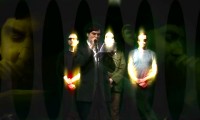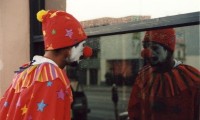John Erman, from “The Empath” (Star Trek Episode 67, Season 3, 1968)
Okay, first off: “Star Trek” (the original 1960s series) is awesome. This might not be news to you, dedicated Trekkie, but I spent thirty-two years in the dark—until last week, that is, when I watched my first-ever full episode, chopped into nine-and-a-half minute segments, on YouTube (…no longer available due to a copyright claim by CBS).
I have no idea if this is typical, but much of “The Empath” takes place in a minimalist void reminiscent of the backdrop from Lars von Trier’s “Dogville” and the set of “Parlez-Moi,” a TV Ontario show starring Marc Favreau as Sol, the morosely pedantic, presumably alcoholic, francophone tramp-clown.
Marc Favreau, “Parlez-Moi” (TVO, 1978 – 80)
The plot of “The Empath” begins with Kirk, Jim and Spock landing on a previously undiscovered planet. After a series of painful teleportations, they come across a mute woman, whom Jim, somewhat imperialistically, names “Gem,” and, soon after, some sparkly-robed, complexly foreheaded aliens.
The aliens — stoic, paternal, vaguely communist, possibly gay — turn out to be hostile, and they trap the Enterprise boys (“Phasers on stun!”) in a laser-beam prison. It’s not a particularly effective prison, though, and after the aliens traipse off-screen the triumvirate scoots away with Gem, only to be ambushed by one of the aliens, now inexplicably (though conveniently) solo. They escape again, this time thanks to Spock doing that neck-pinch thing, which sends the alien into a slow, wilting collapse. (A nerd-bully in my grade six class used to try this stupid move on me all the time — it never worked, but might be the reason I’ve avoided “Star Trek” for so long.)
As they’re set to flee the planet with Gem, the relentless, blithely enraged aliens turn up again, and Kirk gets zapped by some sort of slow-motion laser, though by the time Gem, Jim, and Spock rush to his aid he seems to be fine again, i.e., back to regular speed. Except now the aliens demand that (as restitution, maybe? then why not Spock?) Kirk become their test subject; to great chagrin and vigorous eyebrow-twitching from Jim, he agrees.
John Erman, from “The Empath Preview Trailer” (Star Trek Ep67-S3, 1968)
Kirk ends up crucified, harangued and shot with pain lasers by the aliens, while Gem crouches nearby and, as per the episode’s title, absorbs his pain. The continuity guys must have gone to sleep on this one, as the previous scene concluded with Gem vanished by a disappearing laser — but, anyway, here she is, her tortured, empathetic face rendered in soft-focus and accompanied with searing, plaintive-sounding violins every time Kirk gets zapped.
John Erman, from “The Empath” (Star Trek Episode 67, Season 3, 1968)
I won’t wreck the ending, but rest assured that lasers/phasers are involved.
John Erman, from “The Empath” (Star Trek Episode 67, Season 3, 1968)
I’ve been being glib, but there’s a remarkable dream-logic to “Star Trek” that I like a whole bunch (or at least this episode; keep in mind it’s the only one I’ve seen. You can watch the whole thing here). It reminds me, in the best way, of “Dr. Snuggles,” a show I watched as a kid and which similarly abandoned typical notions of causality, motivation and narrative convention. It’s also hugely refreshing, as so much of the appeal is based on the agency afforded to the viewer in the storytelling process. It’s up to us to make this place make sense and understand it as a world.
Jeffrey O’Kelly, “Dr. Snuggles” (1979)
Here’s Lars von Trier, interviewed about his film “Dogville.” “The problem is that now, it has become too easy—all you have to do is buy a computer and you have filmic. You have armies rampaging over mountains, you have dragons. You just push a button… It’s another art form, I’m sure, but I’m not interested. I don’t see armies going over mountains, I only see some youngster with a computer saying, ‘Let’s do this a little more tastefully, let’s put some shadows in, let’s bleach the colours out a little.’ It’s extremely well done and it doesn’t move me at all. It feels like manipulation to a degree that I don’t want to be manipulated.”
Amazingly, von Trier said all this five years before “Avatar.” When a whole universe, like that $300 million one, is, to every trembling, digital leaf, detailed for us, we don’t need to do any work; we just sit in voyeuristic awe and marvel at the spectacle. There’s no place for us in that world, which doesn’t require our imaginations to complete it: everything flutters and ripples before us in all its vivid, lurid, 3D glory.
Below, James Cameron talks about how “Avatar” restores humanity to CGI creatures by mimicking the actual actors’ facial expressions—thus, he claims, traversing the animator’s “uncanny valley” to the realm of naturalism.
James Cameron, “Avatar: Motion Capture Mirrors Emotions” (2009)
This to me couldn’t be any more boring. Give me a weird crinkly-browed Star Trek alien any day over those sleek blue animatronic creeps. “Avatar” just seems so instructive, so limiting, so delighted by its own trickery. It holds the audience at a distance, if not disregard. There’s much more dignity, to me, in the minimalism (maybe budgetary, but whatever) and anti-naturalism (maybe amateurism, but, again, whatever) to “Star Trek,” or at least the 50-odd minutes I know of it.
Of course this is artifice, seems to be the admission, and as such it demands a pact with viewers — willingness to concurrently suspend our disbelief and become participants, not just spectators, in the show’s creation.
In the black voids of “The Empath” and “Dogville” and, sure, “Parlez-Moi,” there is room for the viewer: We fill them out and up with details from our own minds and lives. We participate in these worlds; they require us to be active and engaged. While I have no clue as to the actual neuro-psychology of the whole enterprise, as an experience it feels close to reading.
I enjoyed Cormac McCarthy’s most recent novel, “The Road,” very much. Part of what makes it work, as Oprah might tell you, is the sparseness of the language: Those sentences are perfectly commensurate with the desolate world they invent and capture. The film adaptation was okay, but if it was missing anything it was that nothing was missing — the book was about absence, while in the movie everywhere you looked was something.
John Hillcoat, “The Road” (2009)
It seems counterintuitive to try convey the gaps between words, the emptiness of white paper onto and from which a reader projects his or her own fantasies, through cinematic starkness. That bleak, gray sky in the above clip still has presence: it looms, it takes up a place in the viewer’s visual field; every pixel of it exists in space and time.
An unmentioned sky in a book, of course, isn’t there at all; a sky that is only “a sullen murk” (a studio’s-worth of digital rendering summed up in two, perfect words) is much more poignant because we have to imagine how, exactly, that might look — and in so doing it becomes our own, unique to each of us inside our brains.
I’d never suggest that books are better than movies. I love movies — so much that I confused that love with wanting to make one, and went, stupidly, to film school, where I wrote, directed, shot, edited and produced arguably the worst piece of cinema ever made (and dropped out a few weeks later). And, after everything I’ve said here, I kind of liked “Avatar.” It looked great. But everything about that world was explicitly shown to me, and the only work I had to do was keep the 3D glasses on my face.
“Plenitude—experiencing all the space as filled—means impenetrability,” wrote Susan Sontag. The aesthetic totality (or what seems an attempt at something like that) of “Avatar” creates an experience, Sontag might tell us, “to which the audience can add nothing… not even add its thought.”
All we walk out of “Avatar” with is a pedantic message (and a cumbersome, confused one at that) that has been projected onto the screen, and us, for 160 minutes. We stumble into the daylight knowing everything about this movie and what it has tried to say.
What’s wrong with a bit of a void?
Spalding Gray, “Monster in a Box” (1992)
– Pasha Malla











